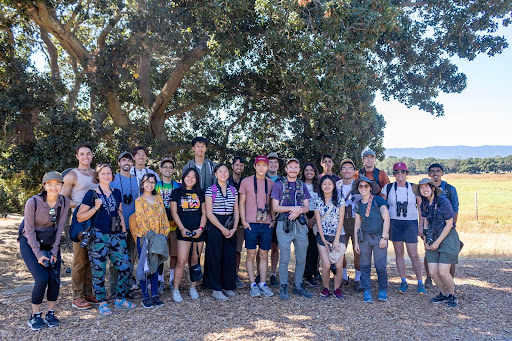On Nov. 11, the Birding Big Game between Stanford Birdwatching Club (SBC) and Berkeley’s Bears for Birds took SBC members to the O’Donohue Family Stanford Educational Farm. Avid members of SBC crowded near a row of peppers, excitedly discussing the covey of quails running in the distance.
“It’s our state bird,” said third-year Ph.D. student Noah Eckman, vice president of SBC.
The Nov. 11 matchup was the third of its kind between the two birdwatching clubs, with the first taking place in 2014 and the second this past spring. The objective of the competition is simple: to identify the most bird species on each campus’s grounds.
According to SBC president and fifth-year Ph.D. student Adam Burnett, Stanford has an inherent advantage due to its proximity to so many bird-friendly habitats like the O’Donohue Farm, Lake Lagunita and the Dish. To level the playing field, Burnett said the competition adopted a handicap system where each club would compare its search count to a previously established baseline.
This year, Stanford spotted 86 species and Berkeley found 48. Stanford surpassed their baseline of 83.5 while Berkeley fell short of theirs of 64, making SBC the clear victor.
But these victories are not what matters most to SBC’s birders. “I think the important part is that it was a really fun day,” Burnett said.
The Birding Big Game spanned the whole day, with SBC also holding two group events for birders: a morning walk at the Dish and an evening stroll at the O’Donohue Farm. To prepare, Burnett made a checklist of birds that birders could reference if they wished. Each time Stanford’s team members found a bird, they logged the species and location.
According to Burnett, SBC was founded in 2014. The club experienced a spike in membership post-pandemic due the surge in birding’s popularity during the height of COVID-19. The club maintains a strong presence on Instagram and Slack, the latter of which allows members to post about their latest bird spotting, plan birding trips and help each other identify birds.
SBC “[tries] to have an event every couple of weeks,” Eckman said, with activities consisting of campus bird walks or trips around the Bay Area. According to Eckman, some hot spots for birding on Stanford’s campus are the O’Donohue Farm, the Arboretum and the Arizona Cactus Garden. Birdwatchers may see some of the 150 bird species, around three times the number of mammals on campus.
Burnett said that club attendance seems to be an even split of undergraduate and graduate students. Members range from frosh to alumni like Jacob West Ph.D. ’23, who with his spouse, Jackie West, even brought his nine-month-old son.

Regardless of year, SBC’s members are always on alert, darting their binoculars and craning their necks to see a bird flitting across a tree or soaring across the sky. SBC is so deeply passionate about birds that some members have even reported seeing them in their sleep.
“I had a dream that I saw a California condor in between Wilbur and Stern,” Chloe Cheng ’25 said. The California condor was spotted on Stanford’s campus in 1971 in perhaps one of the last wild sightings in the Bay Area.
Although the California condor is rarely seen, birds that can easily be spotted on campus today are the dark-eyed junco and Anna’s hummingbird.
Cheng said her favorite bird is the short and stout black phoebe, since it was one of the first birds she learned to identify when she began birding in sixth grade.
On the other hand, Iris Qu ’27 is fond of the lanky stilts that can be observed at Baylands Nature Preserve. “They’re the leggy birds, like 70% legs,” she said.
Some members credit Science Olympiad for igniting their interest in birdwatching, including Kunal Arora ’26 and Max Yang ’27, who participated in the “Ornithology” event. Others were inspired by books, like Emily Chu ’27.
After reading the fantasy series “Guardians of Ga’Hoole,” Chu began a six-month long project in which she successfully “called a barn owl to [her] by mimicking its call.”
Apart from birding being a “very relaxing” hobby, Tang also appreciates the varied phenomena of bird behavior, from killdeers performing the “broken leg display” to brown-headed cowbirds participating in brood parasitism.
“They do so many interesting things,” Tang said.
Cheng values birding’s convenience, saying birding is “a relatively accessible way of staying in touch with living beings around us.” She added that birds “tend to be one of the most visible manifestations of a region’s biodiversity and history.”
Although birding may lean on more patience and quietness, for SBC’s members, that does not make it any less engaging.
“A lot of people think birding can be boring and slow,” Chu said. “But if you have that mindset of letting go of your inability to control everything, [birding] is really liberating and therapeutic.”
A previous version of this article misstated a student’s last name and year. The Daily regrets this error.
